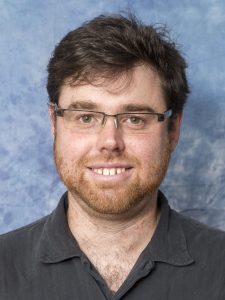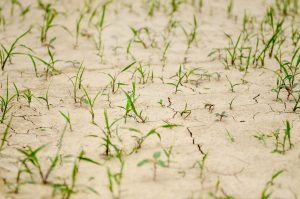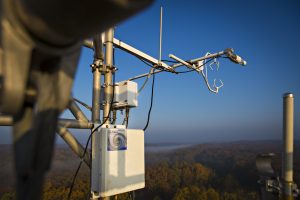In the summer months, Jeff Wood, a biometeorologist in the School of Natural Resources at the University of Missouri, likes to spend his days with his head in the clouds, or at least the canopies of forests. Sometimes starting before dawn and staying until dusk, he uses a 32-meter tall instrument-studded tower at the Missouri Ozark AmeriFlux site (MOFLUX) at the Baskett Wildlife Research and Education Center near Ashland, Missouri, to monitor the “breathing” of the forest. Using tools to measure the flow of carbon dioxide and water from the level of the individual leaf to the entire forest, he hopes to get a sense of the trees’ and other plants’ health and how they are affecting and being affected by the weather and the climate over time scales of seconds to, eventually, decades.

Wood, who has been at MU’s College of Agriculture, Food and Natural Resources since 2016, has been interested in discovering how vegetative systems and the atmosphere interact since his days as an undergraduate in Canada at Mount Allison University when, as a chemistry major, he took an environmental chemistry class. This led him to go to graduate school, at Dalhousie University and University of Guelph respectively, to study environmental engineering and agricultural meteorology.
Wood especially wants to understand the impact of drought on vegetative systems, including crops, but especially forests.
“If you drive through a cornfield in July or August, you easily see the effects of drought,” Wood says. “There are dried crops, and yields may see the damage, but, in the next year, the crops are replanted. With forests, it’s not as clear cut. In forests, past stresses can accumulate. I want to understand the response and resilience to drought. This is important to know because it is thought that drought is going to become more and more common in coming years. Missouri is a good place to study these phenomena because we have a lot of droughts here, and there is a lot of variation in the availability of water.”
One of the challenges to this type of work is that there is no way of remotely monitoring photosynthesis at the scale of whole forests or fields. Research being conducted at MOFLUX is helping to improve this situation.
Somewhat ironically, Wood explains that photosynthesis, the process whereby plants harvest sunlight and carbon dioxide to produce the sugars they need to live and grow, has been modeled from the perspective of the “dark” biochemical reactions that fix carbon dioxide (i.e., what the plant does with the sun’s energy) for the past several decades. This new work seeks to bring the study of photosynthesis into the “light” by looking at it from the light harvesting side.

While Wood isn’t measuring the light reactions directly per se, he wants to study them by measuring something called sun-induced chlorophyll fluorescence (SIF). Basically, Wood says, this is the subtle glow, imperceptible to human eyes, of photosynthesizing plants. SIF is directly tied to photosynthetic activity and can be measured using remote sensing, and thus has the potential to offer scientists a lot more mechanistic information about what stresses the plant is undergoing.
To measure SIF, a robust measurement system that could be continuously deployed in the field was custom designed and built at Oak Ridge National Laboratory and then field-deployed at MOFLUX. Called the Fluorescence Auto Measurement Equipment (FAME), the system was designed to existing systems that measure carbon dioxide and water transfer between the forest and atmosphere. Being able to coordinate these measurements is crucial because each provides unique information that the others do not. The prototype FAME has been in operation on the MOFLUX tower continuously since September 2016.
“Now that we have the monitoring equipment in place, the question is how do you best interpret the signal? What we’ve developed is the first analytical modeling framework that provides an accurate biophysical description of how SIF relates to photosynthesis, and puts us on the path toward finding out what those signals can tell us about the health of the plant, especially how it relates to the plant’s absorption of carbon dioxide, a key indicator of the plant’s health.”

Wood and his team’s latest paper establishes the fundamentals that will provide insight into this relationship, the framework for further work on the applications, and will eventually enable the team to pull more information out of their SIF measurements. They still need to learn a little more about some of the components of their model and how they vary with things like plants’ stress and environment.
The next step is to figure out how key photosynthesis parameters vary in predictable ways so the data can be incorporated into a model. Wood says that they derived slightly different equations depending on the specific way a species of plant photosynthesizes. For instance, corn and soybeans have different photosynthetic pathways, so the equations are slightly different. He believes that they will vary depending on environment factors and in forests there may be some variation depending on where the leaf is situated in the canopy.
One thing the team is very interested in doing is eventually applying this model and validating the output against direct measurements at the leaf level and for the whole forest canopy to make sure that they’re not missing anything, or if the model can be further simplified to make it easier to apply.
“Practically speaking, the ability to measure fluorescence from drones and things like that would turn this into an operational tool for agricultural management decisions, mapping plant stress, being able to better manage for things like drought and so forth,” Wood says. “Eventually we’ll be able be to diagnose where there’s problems and know where plants are performing well and where they are not. That’s very valuable information.”
MOFLUX research is funded by Oak Ridge National Laboratory Terrestrial Ecosystem Science – Science Focus Area. Since 2004, they have provided more than $2 million in support to the project.